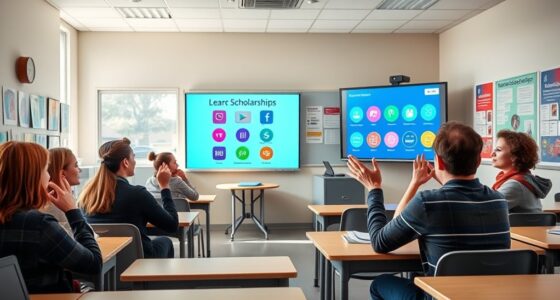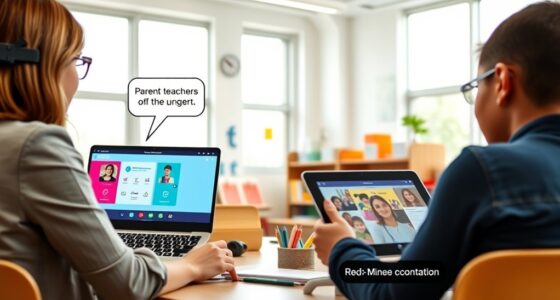To improve listening comprehension in inclusive classrooms, assess your students’ skills regularly and tailor activities to their needs. Create a supportive environment by minimizing distractions and using visual aids like pictures and charts. Incorporate technology such as subtitles and interactive apps, and use collaborative tasks to promote active listening. Scaffold challenging content with clear guidance and feedback. Keep exploring strategies to make your classroom more engaging and accessible for all learners, and you’ll discover even more effective ways to support their growth.
Key Takeaways
- Use differentiated, multisensory strategies like visuals, gestures, and movement to support diverse listening needs.
- Incorporate visual supports and cues to clarify instructions and enhance understanding during listening activities.
- Create a supportive environment by minimizing distractions and positioning students near sound sources.
- Integrate technology such as subtitles, adjustable playback, and interactive apps to facilitate accessible listening practice.
- Regularly assess listening skills through self, peer, and teacher evaluations to tailor activities and track progress.
Assessing Students’ Listening Abilities and Needs

To effectively support students’ listening development, you first need to assess their current abilities and needs. Start by encouraging students to perform student self assessments, which help them reflect on their listening strengths and challenges. Additionally, use listening skill inventories to gather thorough data on their listening strategies, comprehension levels, and areas needing improvement. These tools provide valuable insights into individual differences and guide your planning. By analyzing the results, you can tailor activities and interventions that target specific difficulties. Remember, ongoing assessment is key; it helps you track progress and adjust your approaches accordingly. When you understand each student’s unique listening profile, you’re better equipped to create effective, inclusive learning experiences that foster growth for all learners. Incorporating diverse genres such as anime movies and animated films can also enhance engagement and comprehension skills among students.
Creating a Listening-Rich Classroom Environment
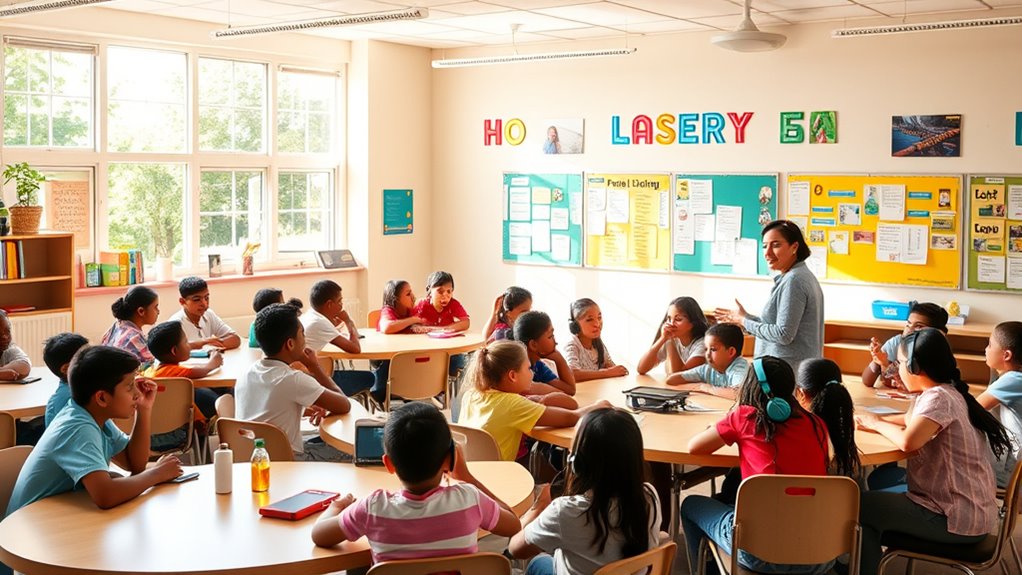
Creating a listening-rich classroom environment begins with intentionally designing spaces and routines that prioritize auditory engagement. Minimize background noise by choosing quiet areas and controlling external distractions, making sure students can focus on instruction. Adjust classroom seating to promote better listening; position students close to the teacher or sound sources, and avoid placing those who need more support near loud vents or windows. Establish routines that encourage active listening, such as eye contact or gentle reminders to pay attention. Use consistent signals to indicate when listening is expected, helping students understand when to focus. A well-organized environment reduces confusion and auditory overload, fostering an atmosphere where all students can develop their listening skills effectively. Additionally, being aware of the operating hours of nearby resources can help schedule activities more efficiently and reduce unnecessary disruptions.
Incorporating Visual Supports to Enhance Comprehension
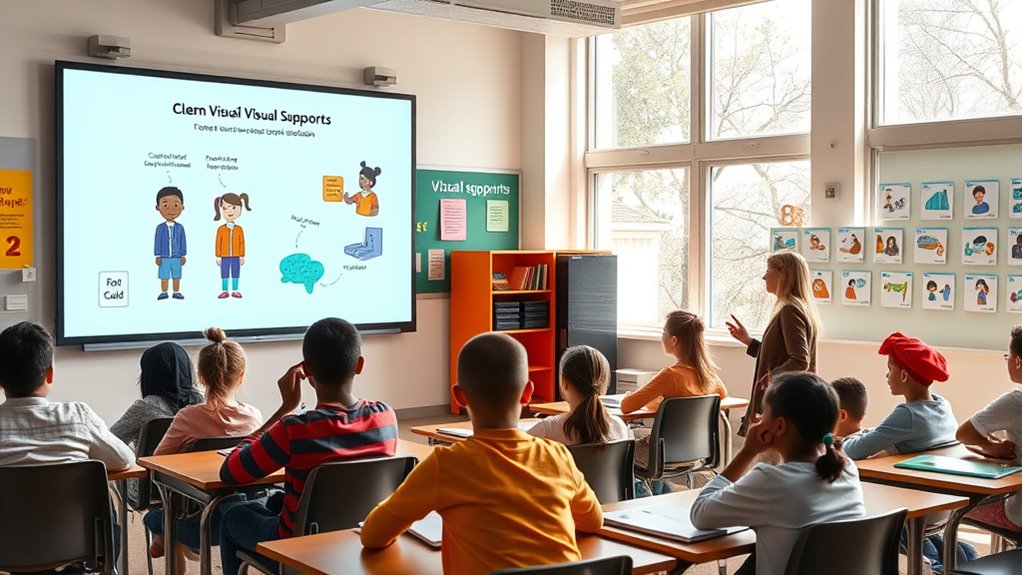
Incorporating visual supports into your classroom can substantially boost students’ comprehension, especially for those who struggle with auditory information alone. Visual storytelling, such as using pictures and diagrams, helps students connect ideas and follow narratives more easily. Picture cues are particularly effective in providing immediate context, making abstract concepts more concrete. By integrating visual supports, you give students additional clues that reinforce listening comprehension. These cues can be displayed on charts, slides, or handouts, allowing students to refer back as needed. Visual storytelling also encourages active engagement, helping students process and retain information better. Utilizing visual aids and cues as part of your teaching strategy can further enhance understanding and retention. When used consistently, visual supports become a powerful tool for making listening activities clearer and more accessible for all learners.
Using Differentiated Instruction to Meet Diverse Learners
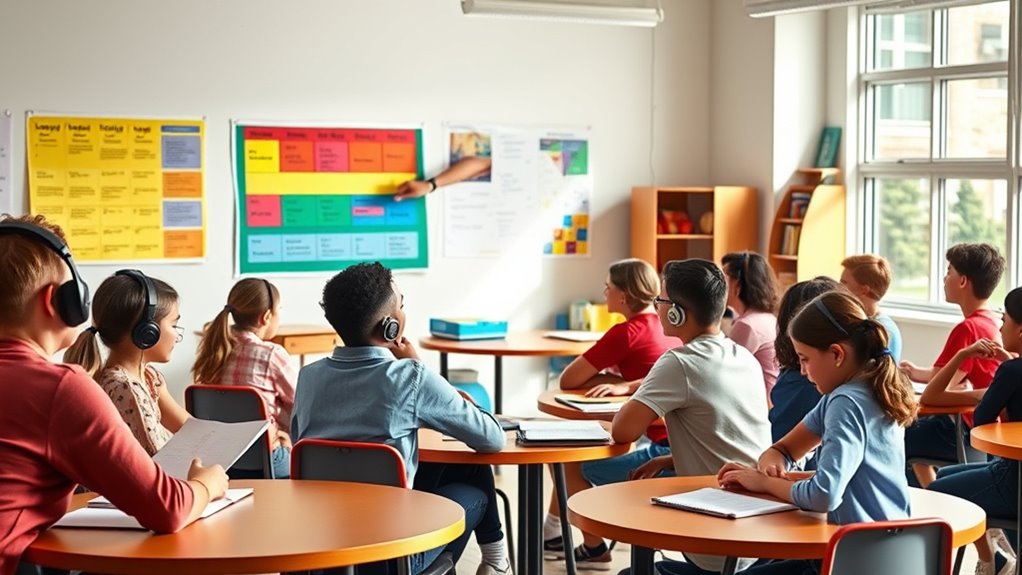
Building on the use of visual supports, tailoring instruction to meet the diverse needs of learners guarantees that every student can access and understand listening activities. You can achieve this by applying multisensory techniques that engage multiple senses, such as combining visuals, sounds, and movement. These methods help students process information more effectively, especially those with different learning styles. Additionally, use culturally responsive methods to incorporate students’ backgrounds and experiences, making listening tasks more relevant and engaging. Differentiated instruction allows you to modify content, process, or product based on individual needs. By combining multisensory approaches with culturally responsive strategies, you create an inclusive environment where all learners have equitable opportunities to develop listening skills and participate actively. Incorporating well-being tips into classroom routines can also support students’ emotional readiness and focus during listening activities.
Implementing Interactive Listening Activities
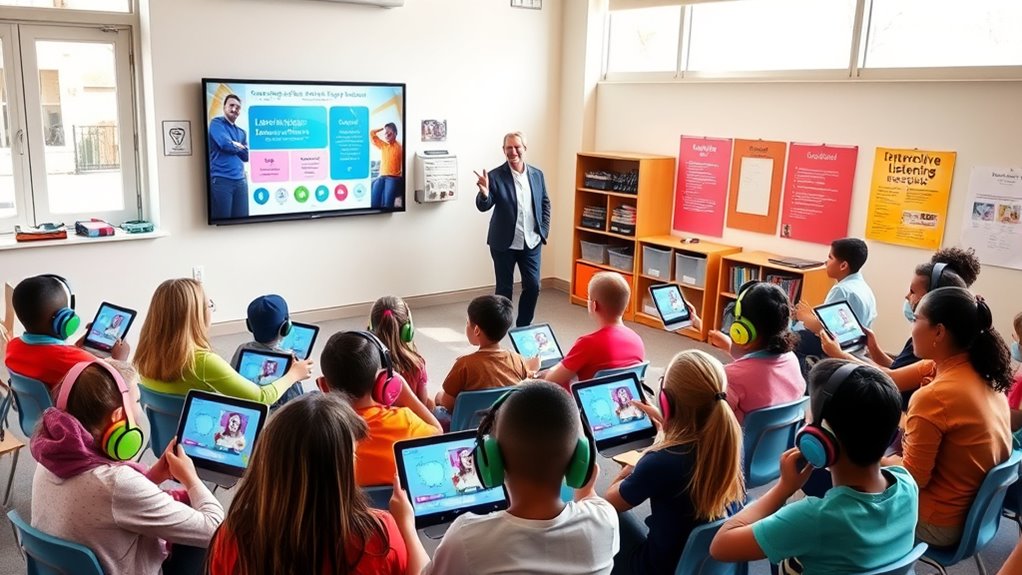
Implementing interactive listening activities transforms passive listening into an engaging learning experience. You can achieve this by incorporating dialogue simulations, where students practice real-life conversations, promoting active participation. These simulations encourage learners to listen carefully and respond appropriately, building confidence and comprehension. Additionally, storytelling techniques make listening more enthralling; ask students to listen to stories and then retell or analyze them. This approach enhances understanding of context, tone, and main ideas. Using audio quality considerations ensures that students can clearly hear details, which is vital for developing listening skills. By integrating these activities into your lessons, you create dynamic opportunities for students to develop listening skills while staying engaged. Remember to tailor activities to your students’ interests and language levels, ensuring everyone remains motivated and involved in the learning process.
Teaching Listening Strategies Explicitly
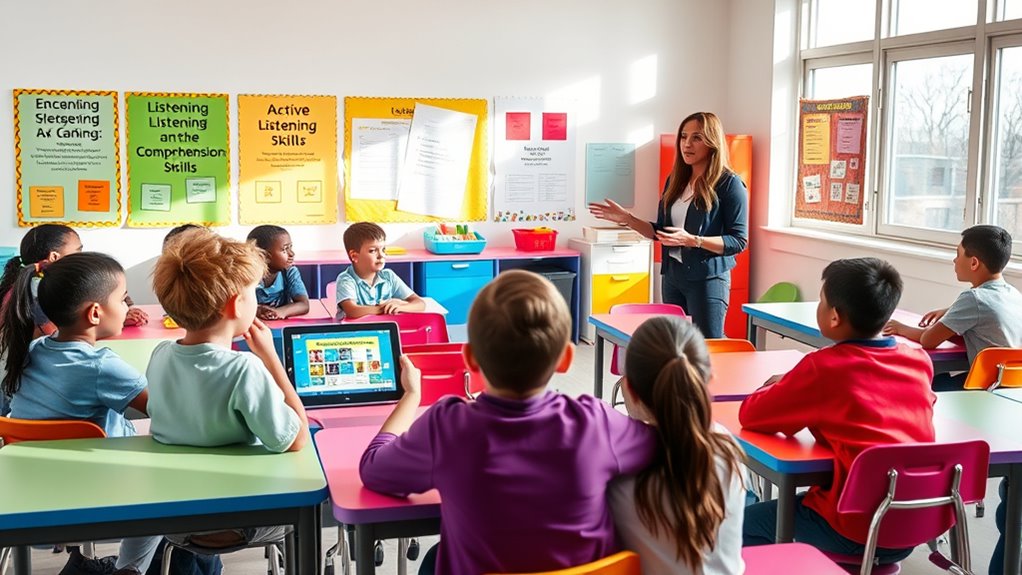
Teaching listening strategies explicitly is essential for helping students become more effective and independent listeners. When you teach strategies directly, you address cultural considerations and emotional awareness, creating a supportive environment. Explicit instruction helps students understand how to focus their attention, interpret tone, and manage emotions during listening. Use a table to vary the teaching approach:
| Strategy | Example |
|---|---|
| Active Listening | Nodding, paraphrasing |
| Cultural Sensitivity | Recognizing cultural cues |
| Emotional Awareness | Identifying feelings in spoken language |
| Note-Taking | Jotting key points |
| Clarification Questions | Asking for repetition or explanation |
This structured approach ensures all students develop skills tailored to their needs and backgrounds, fostering confidence and comprehension. Incorporating performance metrics can help educators assess the effectiveness of their listening strategies and make necessary adjustments.
Leveraging Technology to Support Listening Skills

Technology offers valuable tools to enhance listening skills in your classroom. Assistive listening devices can help students hear more clearly, while interactive listening apps engage them actively. Incorporating these tools can make listening practice more accessible and effective for all learners.
Assistive Listening Devices
Assistive listening devices (ALDs) play a essential role in enhancing listening comprehension for students with hearing challenges in inclusive classrooms. These devices help students hear the teacher’s voice more clearly by reducing background noise and amplifying sound directly to the user. Hearing aids and cochlear implants are common ALDs that support students’ listening needs. Hearing aids amplify sounds in the environment, making speech easier to understand, while cochlear implants directly stimulate the auditory nerve for those with profound hearing loss. By integrating these devices into the classroom, you create a more accessible learning environment. Properly fitting and maintaining hearing aids and cochlear implants ensure students receive the maximum benefit. ALDs empower students to participate actively, improving their listening skills and overall engagement.
Interactive Listening Apps
Have you considered how interactive listening apps can transform the way students develop their listening skills? These apps offer engaging, multimedia content that caters to diverse learning needs, making listening practice more interactive and accessible. They help bridge language barriers by providing subtitles, translations, and adjustable playback speeds, allowing students to learn at their own pace. For students from different cultural backgrounds, these apps often feature diverse voices and contexts, promoting cultural understanding and reducing misunderstandings. By integrating interactive listening apps into your classroom, you create an inclusive environment where all students can improve their listening comprehension—regardless of language limitations or cultural differences. Additionally, incorporating cultural diversity in the content helps students build empathy and appreciation for different backgrounds. These tools empower students to practice independently while fostering confidence and active engagement in learning.
Promoting Active Listening Through Collaborative Tasks

To effectively promote active listening in inclusive classrooms, incorporating collaborative tasks encourages students to engage more deeply with spoken content. Peer collaboration and group discussions motivate students to pay close attention, as they rely on each other to complete tasks. When students work together, they actively process information, ask questions, and clarify understanding, which enhances listening skills. Group discussions create a dynamic environment where students practice listening attentively to diverse perspectives. This shared responsibility fosters focus and accountability, making listening more purposeful. Additionally, incorporating eye patch benefits into classroom activities can help students become more aware of their visual focus and attention, further supporting active listening. By designing activities that require cooperation, you help students develop both listening and communication skills simultaneously. These collaborative tasks make listening an interactive experience, increasing engagement and improving overall comprehension.
Providing Scaffolding and Support for Challenging Content

You can make challenging content more accessible by using visual aids to clarify key ideas. Providing step-by-step guidance helps students follow complex instructions more confidently. Simplifying language guarantees everyone can understand the material without feeling overwhelmed. Incorporating ethical hacking techniques as examples can also make technical concepts more engaging and relatable.
Visual Aids Integration
How can visual aids effectively support students in understanding challenging listening materials? Visual cues enhance comprehension by providing concrete references that complement speech clarity. They help students connect spoken words to images, making abstract or complex ideas more accessible. Using visual aids like charts, diagrams, and pictures scaffolds learning, especially when content is tough. Here’s a helpful table illustrating different types of visual supports:
| Visual Aid | Purpose |
|---|---|
| Infographics | Summarize key points and highlight main ideas |
| Diagrams | Show relationships between concepts |
| Pictures | Provide context and enhance memory |
| Charts | Organize data visually for easier interpretation |
| Captioned Videos | Combine speech with visual cues for better understanding |
Additionally, incorporating visual aids like flowcharts can guide students through complex processes step-by-step, further supporting comprehension.
Step-by-Step Guidance
When students encounter difficult listening materials, providing step-by-step guidance can make a significant difference in their understanding. You can do this by breaking down complex content into smaller, manageable parts. Create structured listening environments where students can focus on one concept at a time, reducing overwhelm. Use guiding questions or prompts to direct their attention and encourage active engagement. As students progress through each step, check for understanding and offer immediate support if needed. This scaffolding helps build confidence and keeps student engagement high, especially when the content feels challenging. By gradually increasing the complexity, you foster a supportive learning atmosphere that helps students develop better listening skills and stay motivated to overcome difficulties.
Simplified Language Use
Using simplified language is a powerful way to support students when tackling challenging listening content. You can improve speech clarity by speaking slowly and enunciating words clearly, making it easier for students to follow along. Vocabulary simplification also helps; replace complex terms with familiar, straightforward words. This scaffolding reduces confusion and builds confidence as students process new information. When you adjust your language, you create an inclusive environment where all students can access the content, regardless of language proficiency or background. Remember, the goal is to make challenging material approachable without diluting its meaning. By consciously using clear speech and simpler vocabulary, you enhance students’ listening comprehension and encourage active engagement in the learning process.
Monitoring Progress and Adjusting Strategies Accordingly
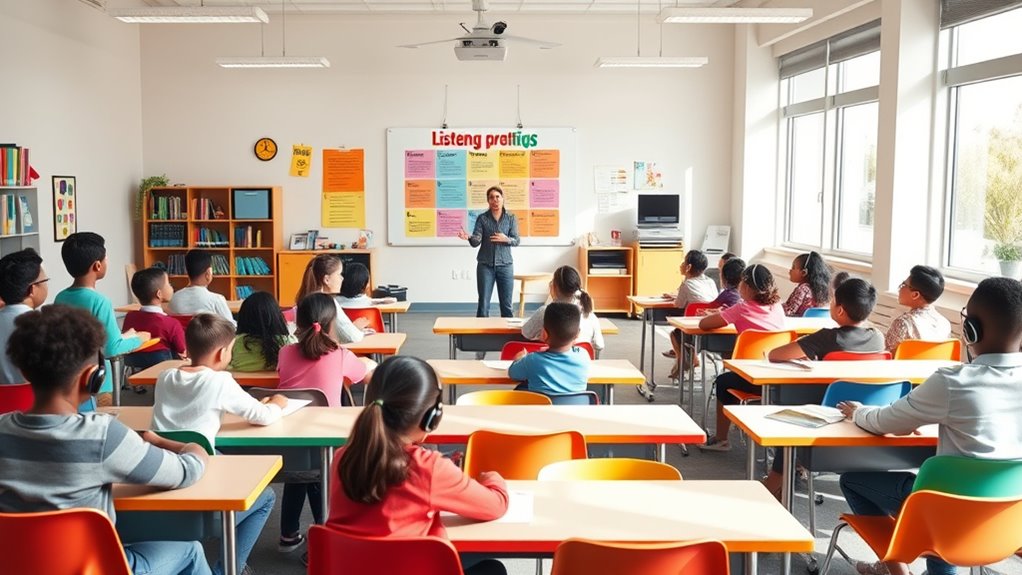
To guarantee listening comprehension strategies are effective in inclusive classrooms, it’s essential to continuously monitor student progress and adjust approaches as needed. You can encourage student self-assessment, which helps learners reflect on their understanding and identify areas for improvement. Peer feedback also plays a crucial role, as students can share insights and support each other’s growth. By regularly observing classroom interactions and listening activities, you gather valuable data on what works best. If students struggle, consider modifying strategies like using visual aids or simplifying instructions. Keep communication open, and involve students in decision-making. This ongoing process ensures your teaching remains responsive, fostering a supportive environment where all students can improve their listening skills effectively.
Frequently Asked Questions
How Can Teachers Foster Motivation to Improve Listening Skills?
To foster motivation to improve listening skills, you can use engagement strategies like interactive activities and real-life topics that resonate with students. Incorporate motivation techniques such as setting achievable goals and providing positive feedback. By making lessons relevant and enjoyable, you encourage students to stay attentive and enthusiastic to practice their listening skills. This approach boosts their confidence and helps them stay motivated to improve consistently.
What Role Do Parents Play in Developing Listening Comprehension?
You play a vital role in developing listening comprehension by fostering parent involvement and encouraging home practice. When you engage with your child through conversations, reading, and listening activities, you reinforce their skills outside the classroom. Your support and active participation make a difference, helping your child build confidence and improve their listening abilities. Consistent home practice, guided by your involvement, creates a strong foundation for their ongoing language development.
How Do Cultural Differences Affect Listening Comprehension Strategies?
Cultural differences considerably influence your listening comprehension strategies. Cultural norms shape how you interpret tone, context, and non-verbal cues, affecting understanding. Language barriers can make it harder to grasp new vocabulary or idiomatic expressions, so you might need to adjust your approach. By being aware of these differences, you can develop more effective strategies, like asking clarifying questions or practicing active listening, which help bridge cultural gaps and enhance understanding.
What Are Common Misconceptions About Inclusive Listening Instruction?
You might think inclusive listening instruction is just about giving everyone equal time, but many fall into assumption pitfalls, believing it’s only about accommodations. Misinterpretation myths also persist, like assuming all students learn the same way or that one method fits all. In reality, effective inclusive listening involves tailored strategies that address diverse needs, ensuring all students actively engage and comprehend, busting these misconceptions and creating truly inclusive learning environments.
How Can Peer Feedback Enhance Listening Skill Development?
Imagine peer assessment as a mirror reflecting your listening skills. When you engage in collaborative listening, feedback from classmates highlights strengths and reveals areas to improve. This active process helps you become more aware of your listening habits, making skill development more effective. Peer feedback turns listening into a team effort, encouraging you to refine your skills through shared insights and mutual support, ultimately boosting your confidence and comprehension.
Conclusion
By applying these strategies, you’re well on your way to transforming your inclusive classroom. But the real question remains: how will you adapt and refine your approach to truly open every student’s listening potential? The journey doesn’t end here—each step you take brings new opportunities for growth and discovery. Are you ready to uncover the secrets that will make listening comprehension a powerful tool for all your learners? The next chapter awaits.





